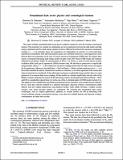Por favor, use este identificador para citar o enlazar a este item:
http://hdl.handle.net/10261/216186COMPARTIR / EXPORTAR:
 SHARE SHARE
 CORE
BASE CORE
BASE
|
|
| Visualizar otros formatos: MARC | Dublin Core | RDF | ORE | MODS | METS | DIDL | DATACITE | |

| Título: | Nonminimal dark sector physics and cosmological tensions |
Autor: | Di Valentino, Eleonora; Melchiorri, A.; Mena, Olga CSIC ORCID; Vagnozzi, S. | Fecha de publicación: | mar-2020 | Citación: | Physical Review D 101 (6): 063502 (2020) | Resumen: | We explore whether nonstandard dark sector physics might be required to solve the existing cosmological tensions. The properties we consider in combination are (a) an interaction between the dark matter and dark energy components and (b) a dark energy equation of state w different from that of the canonical cosmological constant w=-1. In principle, these two parameters are independent. In practice, to avoid early-time, superhorizon instabilities, their allowed parameter spaces are correlated. Moreover, a clear degeneracy exists between these two parameters in the case of cosmic microwave background (CMB) data. We analyze three classes of extended interacting dark energy models in light of the 2019 Planck CMB results and Cepheid-calibrated local distance ladder H0 measurements of Riess et al. (R19), as well as recent baryon acoustic oscillation (BAO) and type Ia supernovae (SNeIa) distance data. We find that in quintessence coupled dark energy models, where w>-1, the evidence for a nonzero coupling between the two dark sectors can surpass the 5σ significance. Moreover, for both Planck+BAO or Planck+SNeIa, we find a preference for w>-1 at about three standard deviations. Quintessence models are, therefore, in excellent agreement with current data when an interaction is considered. On the other hand, in phantom coupled dark energy models, there is no such preference for a nonzero dark sector coupling. All the models we consider significantly raise the value of the Hubble constant, easing the H0 tension. In the interacting scenario, the disagreement between Planck+BAO and R19 is considerably reduced from 4.3σ in the case of the Λ cold dark matter (ΛCDM) model to about 2.5σ. The addition of low-redshift BAO and SNeIa measurements leaves, therefore, some residual tension with R19 but at a level that could be justified by a statistical fluctuation. Bayesian evidence considerations mildly disfavor both the coupled quintessence and phantom models, while mildly favoring a coupled vacuum scenario, even when late-time datasets are considered. We conclude that nonminimal dark energy cosmologies, such as coupled quintessence, phantom, or vacuum models, are still an interesting route toward softening existing cosmological tensions, even when low-redshift datasets and Bayesian evidence considerations are taken into account. | Versión del editor: | http://dx.doi.org/10.1103/PhysRevD.101.063502 | URI: | http://hdl.handle.net/10261/216186 | DOI: | 10.1103/PhysRevD.101.063502 | Identificadores: | doi: 10.1103/PhysRevD.101.063502 issn: 2470-0029 |
| Aparece en las colecciones: | (IFIC) Artículos |
Ficheros en este ítem:
| Fichero | Descripción | Tamaño | Formato | |
|---|---|---|---|---|
| 26_Mena_Nonminimal.pdf | 1,05 MB | Adobe PDF |  Visualizar/Abrir |
CORE Recommender
SCOPUSTM
Citations
211
checked on 05-may-2024
WEB OF SCIENCETM
Citations
194
checked on 21-feb-2024
Page view(s)
107
checked on 07-may-2024
Download(s)
132
checked on 07-may-2024
Google ScholarTM
Check
Altmetric
Altmetric
Este item está licenciado bajo una Licencia Creative Commons

